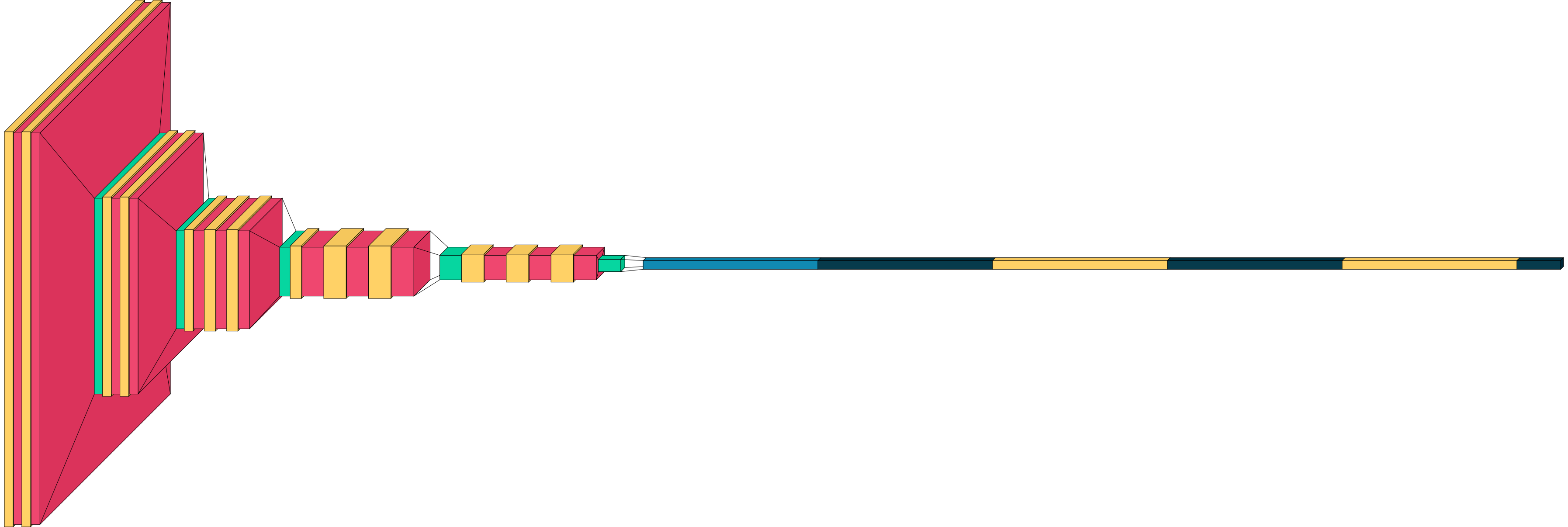Visualkeras is a Python package to help visualize Keras (either standalone or included in tensorflow) neural network architectures. It allows easy styling to fit most needs. This module supports layered style architecture generation which is great for CNNs (Convolutional Neural Networks), and a graph style architecture, which works great for most models including plain feed-forward networks.
| Mode | Sequential | Functional | Subclassed models |
|---|---|---|---|
visualkeras.layered_view() |
yes(1) | partially(1,2) | not tested |
visualkeras.graph_view() |
yes | yes | not tested |
1: Any tensor with more than 3 dimensions will be rendered as 3D tensor with elongated z-axis.
2: Only linear models where each layer has no more than one in or output. Non-linear models will be shown in sequential order.
To install published releases from PyPi execute:
pip install visualkerasTo update visualkeras to the latest version, add the --upgrade flag to the above commands.
If you want the latest (potentially unstable) features you can also directly install from the github master branch:
pip install git+https://github.com/paulgavrikov/visualkerasGenerating neural network architectures is easy:
import visualkeras
model = ...
visualkeras.layered_view(model).show() # display using your system viewer
visualkeras.layered_view(model, to_file='output.png') # write to disk
visualkeras.layered_view(model, to_file='output.png').show() # write and showTo help understand some of the most important parameters we are going to use a VGG16 CNN architecture (see example.py).
visualkeras.layered_view(model)You can set the legend parameter to describe the relationship between color and layer types. It is also possible to pass
a custom PIL.ImageFont to use (or just leave it out and visualkeras will use the default PIL font). Please note that
you may need to provide the full path of the desired font depending on your OS.
from PIL import ImageFont
font = ImageFont.truetype("arial.ttf", 32) # using comic sans is strictly prohibited!
visualkeras.layered_view(model, legend=True, font=font) # font is optional!visualkeras.layered_view(model, draw_volume=False)The global distance between two layers can be controlled with spacing. To generate logical groups a special dummy
keras layer visualkeras.SpacingDummyLayer() can be added.
model = ...
...
model.add(visualkeras.SpacingDummyLayer(spacing=100))
...
visualkeras.layered_view(model, spacing=0)It is possible to provide a custom color map for fill and outline per layer type.
from tensorflow.python.keras.layers import Dense, Conv2D, Flatten, Dropout, MaxPooling2D, ZeroPadding2D
from collections import defaultdict
color_map = defaultdict(dict)
color_map[Conv2D]['fill'] = 'orange'
color_map[ZeroPadding2D]['fill'] = 'gray'
color_map[Dropout]['fill'] = 'pink'
color_map[MaxPooling2D]['fill'] = 'red'
color_map[Dense]['fill'] = 'green'
color_map[Flatten]['fill'] = 'teal'
visualkeras.layered_view(model, color_map=color_map)Some models may consist of too many layers to visualize or to comprehend the model. In this case it can be helpful to
hide (ignore) certain layers of the keras model without modifying it. Visualkeras allows ignoring layers by their type
(type_ignore) or index in the keras layer sequence (index_ignore).
visualkeras.layered_view(model, type_ignore=[ZeroPadding2D, Dropout, Flatten])Visualkeras computes the size of each layer by the output shape. Values are transformed into pixels. Then, scaling is
applied. By default visualkeras will enlarge the x and y dimension and reduce the size of the z dimensions as this has
deemed visually most appealing. However, it is possible to control scaling using scale_xy and scale_z. Additionally,
to prevent to small or large options minimum and maximum values can be set (min_xy, min_z, max_xy, max_z).
visualkeras.layered_view(model, scale_xy=1, scale_z=1, max_z=1000) Note: Scaled models may hide the true complexity of a layer, but are visually more appealing.
Note: Scaled models may hide the true complexity of a layer, but are visually more appealing.
The main branch may be ahead of pypi. Consider upgrading to the latest (perhaps unstable) build as discussed in Installation.
This is most likely due to missing gcc / g++ components (e.g. on Elementary OS). Try installing them via your package manager, e.g.:
sudo apt-get install gcc
sudo apt-get install g++You have probably not configured your default image viewer. You can install imagemagick via most package managers:
sudo apt-get install imagemagickIf you find this project helpful for your research please consider citing it in your publication as follows.
@misc{Gavrikov2020VisualKeras,
author = {Gavrikov, Paul},
title = {visualkeras},
year = {2020},
publisher = {GitHub},
journal = {GitHub repository},
howpublished = {\url{https://github.com/paulgavrikov/visualkeras}},
}







